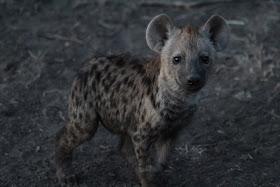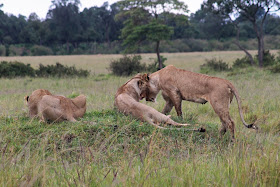Have you ever wondered how Fisi Campers in the Mara Triangle
can collect data tirelessly day after day after day?
Well the secret is that Serena Camp has a backbone that few outside the
project know about. Actually, there are
two backbones, and their names are: Philimon and Moses. They humbly accept the title of “Camp
Attendants”, but what they do on a daily basis is closer to quests of epic-heroes
of ancient history, akin to Gilgamesh and Hercules. Philimon and Moses cook our meals for us, clean
the dishes, wash our clothes, cut the grass to keep venomous snakes at bay, wash
the cars, purify our drinking water, sweep the tents, care for our guests, keep
large game away from camp, care for our guests, fix broken tent zippers,
maintain the tent tarps that keep us dry, prepare goats for inhibition trials, point
out interesting wildlife around camp (like chameleons!), liaison with local
farmers to get all the fruits and veggies we crave…I mean I could literally
write an entire page for the duties they carry out on a daily basis – some of
which aren’t even part of their job description, but they do it anyway just
because they know it will make us happy.
Most of the time, they know what we need even before we ourselves
know. Fresh towels will mysteriously
show up outside tents, zippers will be magically fixed before we even have the
opportunity to report them as broken, cakes will be baked to take out as snacks on observations without
prompting (Their excuse was that we had extra sugar that they wanted to use), and
even when the Triangle is over 50% mud we will still have the cleanest cars in
the Mara. There are even whispers that
Philimon and Moses can influence local weather patterns for short periods of
time. We go out many a night in the
rainy seasons and look up at the sky to realize that there is a singular shaft
of light shining over camp and the territory we’re working in, surrounded by
torrential downpours. It still remains unclear
just how the guys channel this degree of environmental energy.
 |
| Philimon and Moses' pride and joy...behold the immaculacy of the Serena kitchen tent, the source of all of Serena's culinary happiness. |
The most egregious example of their complete and utter
desire to, not only go above and beyond their basic responsibilities, but decrease
the amount of stress in our lives was when we were attempting to get a wiring
guru from the town of Kilgoris down to the camp to perform a life-saving
electrical overhaul on KAL. We kept
getting blown off by this fellow, who had one excuse after another. Philimon deemed this situation unacceptable with
the cruiser just idling away in the driveway and unable to be used for observations, so unbeknownst
to us he called a bunch of mechanics and demanded to know where he could find a
wiring specialist with the professional know-how to get KAL back into the
fight. The next day an electrician from
Itong came to camp, completely rewired the cruiser in a single day (it was
expected to be a three-day job) and we haven’t had an electrical problem with
KAL ever since. If you ask the guys why
they do what they do, they’ll tell you: “We do everything we can to make [the
RA’s] lives easy so [the RA’s] only focus on their work”. The first time they said this to me was
probably one of the most humbling experiences I’ve had in the last couple of
years, especially given the amount of time they spend away from their own families to take care of us.
 |
| Philimon (left) and Moses (right) with the lab tent in the background. |
Philimon and Moses are truly amazing individuals. So out of appreciation for their incredible
daily efforts, I’d like you guys to get to know a little bit more about
them. Philimon and Moses are brothers,
with Philmon being the elder. They come
from the town of Kilgoris which is about 75km from the Mara Triangle. Grew up in the Naiguran family with five
brothers and 3 sisters, and they hail from the Maasai tribe. In
Kilgoris, Philimon lives on the hill Shartuka with his wife where he has three
boys and five girls of his own. He owns
five dairy cows and grows maize, beans, sweet potatoes, and bananas on his
land. Philimon has worked for the project
for nine years, before which he was a sauce chef at African Safari Club. Meanwhile, Moses lives on the hill Orongai. His family consists of his wife, three boys
and three girls. He grows bananas, skuma (collard
greens), and beans, amongst other small plots of produce. For livestock, Moses keeps eight cows and
seven sheep. Before he worked for Fisi
camp, Moses worked on a hot air balloon crew at Fig Tree camp, but he’s been
going eight years strong with us. When
asked about their favorite meals at home – Philimon went with the age-old
tradition of ugali (a maize flour staple in East Africa), skuma, nyama (meat),
and milk from his cows; while Moses prefers ugali, gtherie (a mix of corns and
beans), and chapatti (a soft flatbread originally from India). In camp, their favorite chore (and pastime)
is walking around camp in the early morning and inspecting the tarps, tents,
and other camp belongings to ensure they’re 1) still present and have not been
stolen by the fisi and 2) are in tip-top shape.
Hm? What’s that? You want to know what their least favorite activity in
camp is? Stop being so foolish, this is Philimon and Moses we’re talking about!
They love every aspect of their jobs, you can ask them yourself if you don’t
believe me!
















